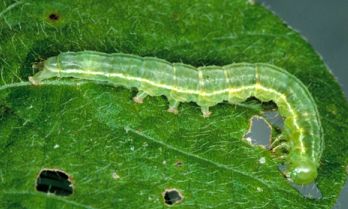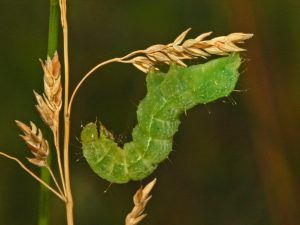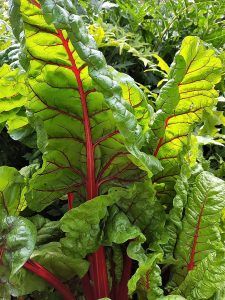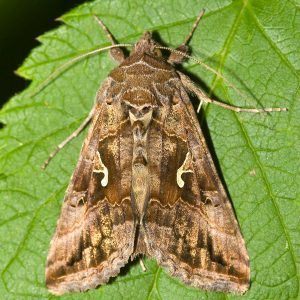Plusia or Green Worm: [Characteristics, Detection, Effects and Treatment]

What is plusia or green worm?
 The Plusia butterfly, with the scientific name Autographa gamma, is a very powerful pest that attacks crops.
The Plusia butterfly, with the scientific name Autographa gamma, is a very powerful pest that attacks crops.
They belong to the Plusiinae subfamily of moths, members of the large Noctuidae family, made up of more than a thousand genera and 11,772 species that continue to record changes.
The Plusiva lives mainly in Europe, throughout the Iberian Peninsula, as well as North Africa and a part of Asia, because it has an accentuated migratory behavior.
They are also popularly known as owl moths, armyworms, cutworms, or armyworms.The worm bites the leaves of plants without any mercy, so its attack can be lethal.
The green worms open embrasures and holes and discharge their detritus, leaving very visible black marks as well, an unmistakable trace of their manure.
How can we identify it?
Identifying the Plusia butterfly following these characteristics will facilitate the task of combating it and will prevent it from spreading by assuming invasive behaviour.
- The Plusia reaches between 3-5 centimeters.
- The wings have some impressive patterns or drawings, with darker shades, between browns and grays that help it to camouflage or hide. Towards the central part of the wings a perfect letter Y can be observed, when the butterfly is at rest.
- Forewings reddish, brownish or orange. And the hindwings are brown. The colors vary according to the region where their larvae have developed. They can also have rounded drawings, with white circular stripes.
- Their habits are nocturnal.
- They lay their eggs on the upper and lower sides of the leaves. They are tiny white hemispheres.
- The chrysalis is protected inside a silky white cocoon. There it lives during the winter, until the adult butterfly comes out in the spring, causing them to proliferate about 2-3 generations a year. A fourth generation can emerge if environmental conditions are favorable for their reproduction.
- Incubation will end after 3-4 days, provided the weather is cool, but it can also take a little longer.
- Their larvae are large leaf eaters that act under the cover of night, leaving large holes and black spots from their manure, which give them away. They also invade fruits, causing a disaster in the crop if they are not stopped in time.
- The larvae measure around 30 millimeters. They have 3 pairs of short legs and are initially green with whitish spots. But then they turn black.
- Adults mate about 2 days after emerging from the pupa, and a few 1-5 days later, they lay their clutches on the leaves of host plants. But they usually die within a few days, lasting between 3-9 days.
- These worms eat a wide variety of herbaceous plants.
What plants are affected by plusia or green worm?
 Green worms invade all kinds of horticultural crops, herbaceous plants.
Green worms invade all kinds of horticultural crops, herbaceous plants.
Swiss chard, lettuce, tomato plants, peas, sugar beets, cabbage, geraniums, tobacco, among many other victims that lose their foliage thanks to the aggressive behavior of these caterpillars that are usually considered a true pest.
So far, some 200 species of affected herbaceous plants have been documented, which of course leads to a reduction in the profit margins of many infected agricultural crops whose fruits will not yield their maximum potential.
How to combat plusia or green worm?
There are several preventive actions that help avoid and control the unwanted visit of these biting caterpillars and adult butterflies. Let’s see.
- Eliminating weeds in crops is essential to eliminate eggs.
- Pheromone traps, which incite sexual attraction between members of this species, is also a good way to control them effectively. They are a method of help to detect and corner them in their first incursions on the crops.
- The permanent review of the leaves, especially in the late afternoon, with the help of a good flashlight, is of great help to suppress the laying of eggs by the butterfly and/or remove worms.
The review of the leaves must be done in all stages of development of the crop, in order to avoid irreversible damage to leaves and stems of shoots and adult plants, although they love to bite the leaves of seedlings.
organic insecticide
An excellent option of organic origin, very easy to prepare, consists of locating and mixing baking soda with flour.
- Combine both powders in similar proportions, calculated at about 100 grams of each.
- This dust will be spread manually on the leaves, in order to scare away the butterflies that seek to make new spawns and their larvae.
- Do this procedure between 2 to 3 days in a row only when there is rain. Not so on dry, sunny days.
What are the best products to eliminate plusia or green worm?
 Bacillus thuringiensis is an ecological insecticide, a bacterium naturally present in the soil that produces great results to combat the green worm and other caterpillars in general.
Bacillus thuringiensis is an ecological insecticide, a bacterium naturally present in the soil that produces great results to combat the green worm and other caterpillars in general.
It generates, when ingested, a toxic protein crystal that kills these little animals before they cause more damage.
As the key lies in controlling the population, when the caterpillar arrives to eat leaves and stems, it is poisoned and dies, not being able to reproduce or leaving behind eggs that will become an invading army.
They do not generate lethal effects on beneficial animals such as bees.This product is available at trusted garden stores. It is a wettable powder that must be diluted in water, according to the attached instructions provided by the manufacturer.
In general, you can put 2 grams in 2 liters of water, preferably rainwater, and pour the mixture into a hand sprayer, which will greatly help in the task of covering the entire plant preventively, without this meaning any risk to the plant. the health of both plants and people.
Similarly, there is also the possibility of combining technological or synthetic pyrethrins with the bacillus. And it also works to a lesser extent to make applications with potassium soap on the leaves, in order to control the appearance of the moths that these caterpillars produce.
As soon as a damaged leaf is seen, an exhaustive review of the leaves should be done to manually remove the biting worms that have reached the orchard.The following products are also available:
- Deltamethrin 2.5: Fights green worm, gray worms,aphids.
- Alpha ipermetrin: Fights green worm, aphids.
- Betaciflutrin 2.5: Combat, green worm.
- Ciflutrin 5: Combat Key, green worm.
- Cypermethrin 10: Fights, green worm, aphids.
- zeta-cypermethrin 10%: Fights green worm, aphids.
- lambda cihalotrin 2.5: Fight Apion, cuca, green worm, aphids.
- lambda cihalotrin 10: Fight Apion, cuca, green worm, aphids.

![Photo of Cedar of Lebanon: [Cultivation, Care, Pests and Diseases]](https://www.complete-gardening.com/wp-content/uploads/2022/08/cedar-of-lebanon-cultivation-care-pests-and-diseases-390x220.jpg)

![Photo of How to Plant Blackberry: Complete Guide [Images + Steps to Follow]](https://www.complete-gardening.com/wp-content/uploads/2022/08/how-to-plant-blackberry-complete-guide-images-steps-to-follow-390x220.jpg)
